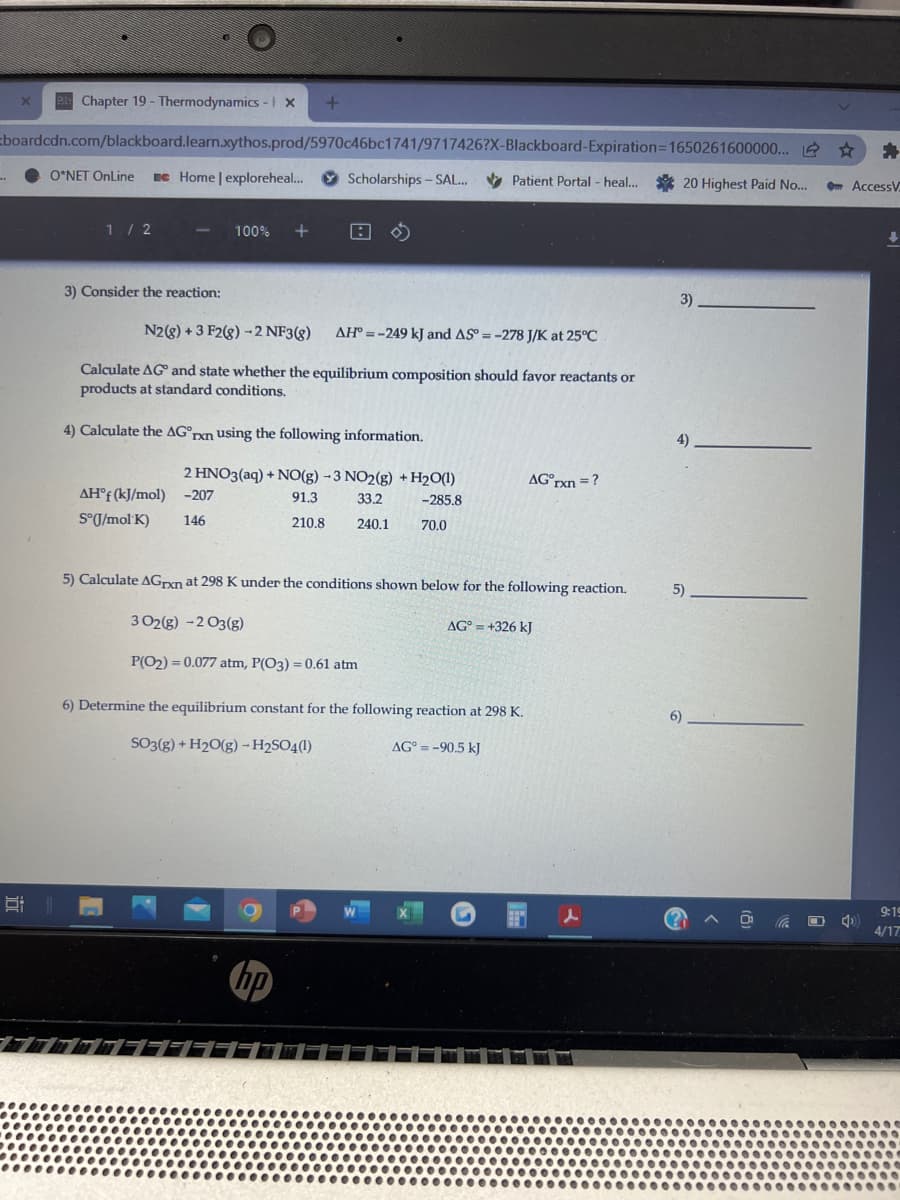3) Consider the reaction: 3) _ N2(8) + 3 F2(g) -2 NF3(g) AH® = -249 kJ and AS = -278 J/K at 25°C %3D Calculate AG and state whether the equilibrium composition should favor reactants or products at standard conditions.
3) Consider the reaction: 3) _ N2(8) + 3 F2(g) -2 NF3(g) AH® = -249 kJ and AS = -278 J/K at 25°C %3D Calculate AG and state whether the equilibrium composition should favor reactants or products at standard conditions.
Chemistry
10th Edition
ISBN:9781305957404
Author:Steven S. Zumdahl, Susan A. Zumdahl, Donald J. DeCoste
Publisher:Steven S. Zumdahl, Susan A. Zumdahl, Donald J. DeCoste
Chapter1: Chemical Foundations
Section: Chapter Questions
Problem 1RQ: Define and explain the differences between the following terms. a. law and theory b. theory and...
Related questions
Question
#3 please

Transcribed Image Text:B Chapter 19 - Thermodynamics - x
Eboardcdn.com/blackboard.learn.xythos.prod/5970c46bc1741/9717426?X-Blackboard-Expiration=D1650261600000...
O*NET OnLine
Ee Home | exploreheal...
Scholarships - SAL.
v Patient Portal - heal...
20 Highest Paid No...
- AccessV
1/2
100%
3) Consider the reaction:
3)
N2(8) + 3 F2(8) -2 NF3(8)
AH° = -249 kJ and AS = -278 J/K at 25°C
Calculate AG and state whether the equilibrium composition should favor reactants or
products at standard conditions.
4) Calculate the AG°rxn using the following information.
4)
2 HNO3(aq) + NO(g) - 3 NO2(g) + H2O(1)
AG°rxn = ?
AH°f (kJ/mol)
-207
91.3
33.2
-285.8
S°J/mol K)
146
240.1
210.8
70.0
5) Calculate AGrxn at 298 K under the conditions shown below for the following reaction.
5)
3 02(g) -2 O3(g)
AG° = +326 kJ
P(O2) = 0.077 atm, P(O3) = 0.61 atm
6) Determine the equilibrium constant for the following reaction at 298 K.
SO3(g) + H2O(g) – H2SO4(1)
AG° = -90.5 kJ
9:19
4/17
hp
Expert Solution
This question has been solved!
Explore an expertly crafted, step-by-step solution for a thorough understanding of key concepts.
This is a popular solution!
Trending now
This is a popular solution!
Step by step
Solved in 5 steps

Knowledge Booster
Learn more about
Need a deep-dive on the concept behind this application? Look no further. Learn more about this topic, chemistry and related others by exploring similar questions and additional content below.Recommended textbooks for you

Chemistry
Chemistry
ISBN:
9781305957404
Author:
Steven S. Zumdahl, Susan A. Zumdahl, Donald J. DeCoste
Publisher:
Cengage Learning

Chemistry
Chemistry
ISBN:
9781259911156
Author:
Raymond Chang Dr., Jason Overby Professor
Publisher:
McGraw-Hill Education

Principles of Instrumental Analysis
Chemistry
ISBN:
9781305577213
Author:
Douglas A. Skoog, F. James Holler, Stanley R. Crouch
Publisher:
Cengage Learning

Chemistry
Chemistry
ISBN:
9781305957404
Author:
Steven S. Zumdahl, Susan A. Zumdahl, Donald J. DeCoste
Publisher:
Cengage Learning

Chemistry
Chemistry
ISBN:
9781259911156
Author:
Raymond Chang Dr., Jason Overby Professor
Publisher:
McGraw-Hill Education

Principles of Instrumental Analysis
Chemistry
ISBN:
9781305577213
Author:
Douglas A. Skoog, F. James Holler, Stanley R. Crouch
Publisher:
Cengage Learning

Organic Chemistry
Chemistry
ISBN:
9780078021558
Author:
Janice Gorzynski Smith Dr.
Publisher:
McGraw-Hill Education

Chemistry: Principles and Reactions
Chemistry
ISBN:
9781305079373
Author:
William L. Masterton, Cecile N. Hurley
Publisher:
Cengage Learning

Elementary Principles of Chemical Processes, Bind…
Chemistry
ISBN:
9781118431221
Author:
Richard M. Felder, Ronald W. Rousseau, Lisa G. Bullard
Publisher:
WILEY